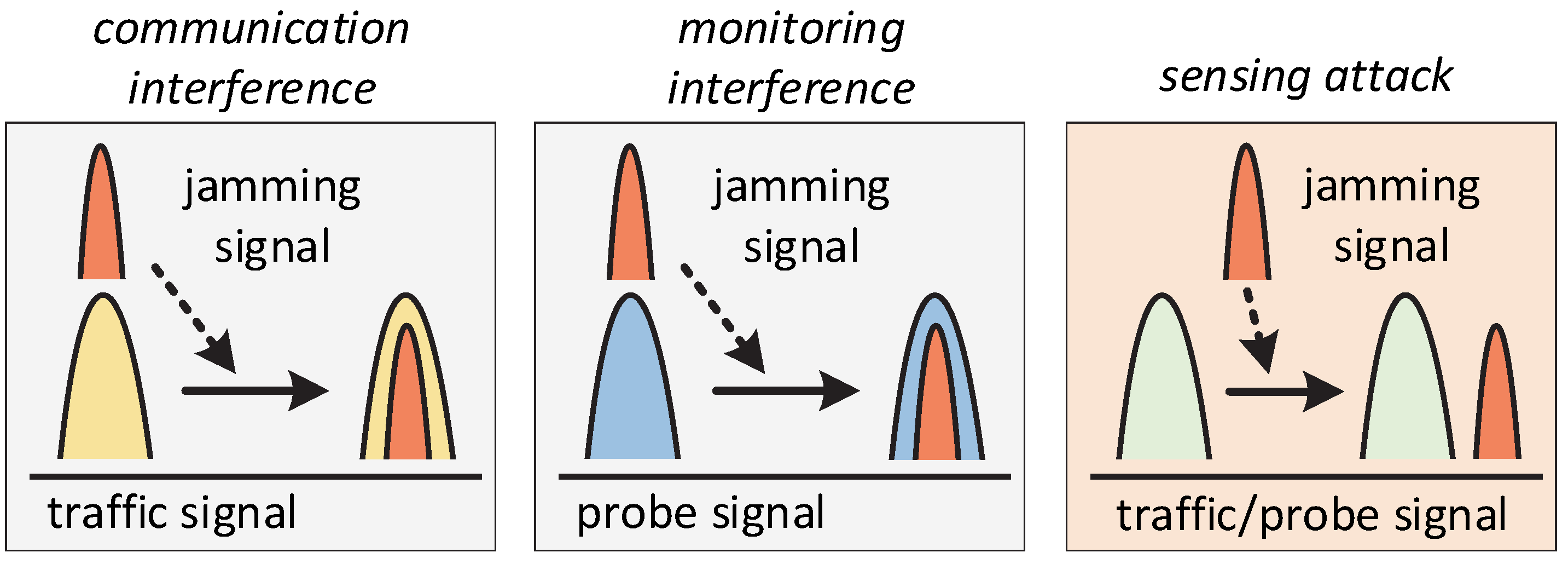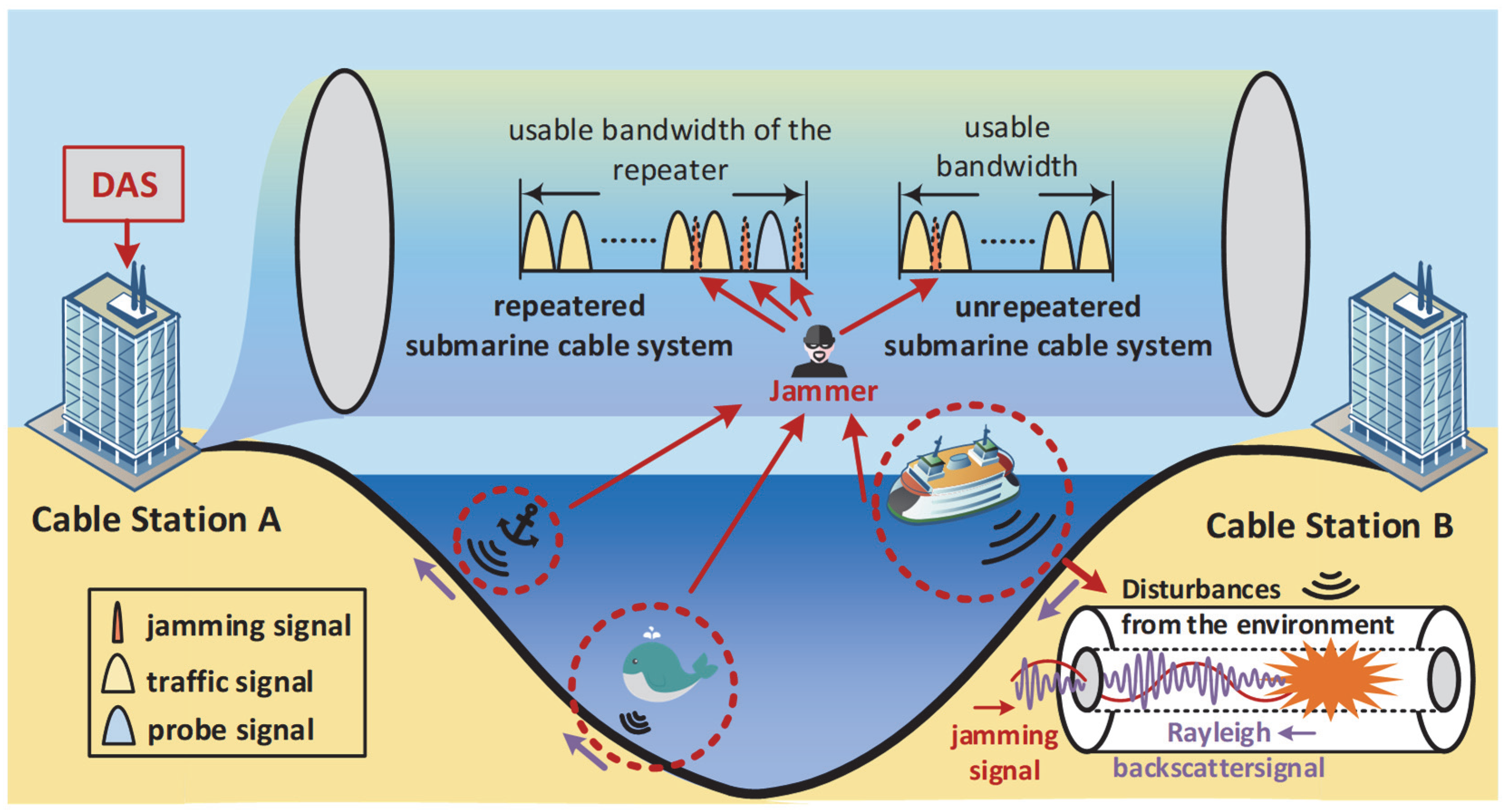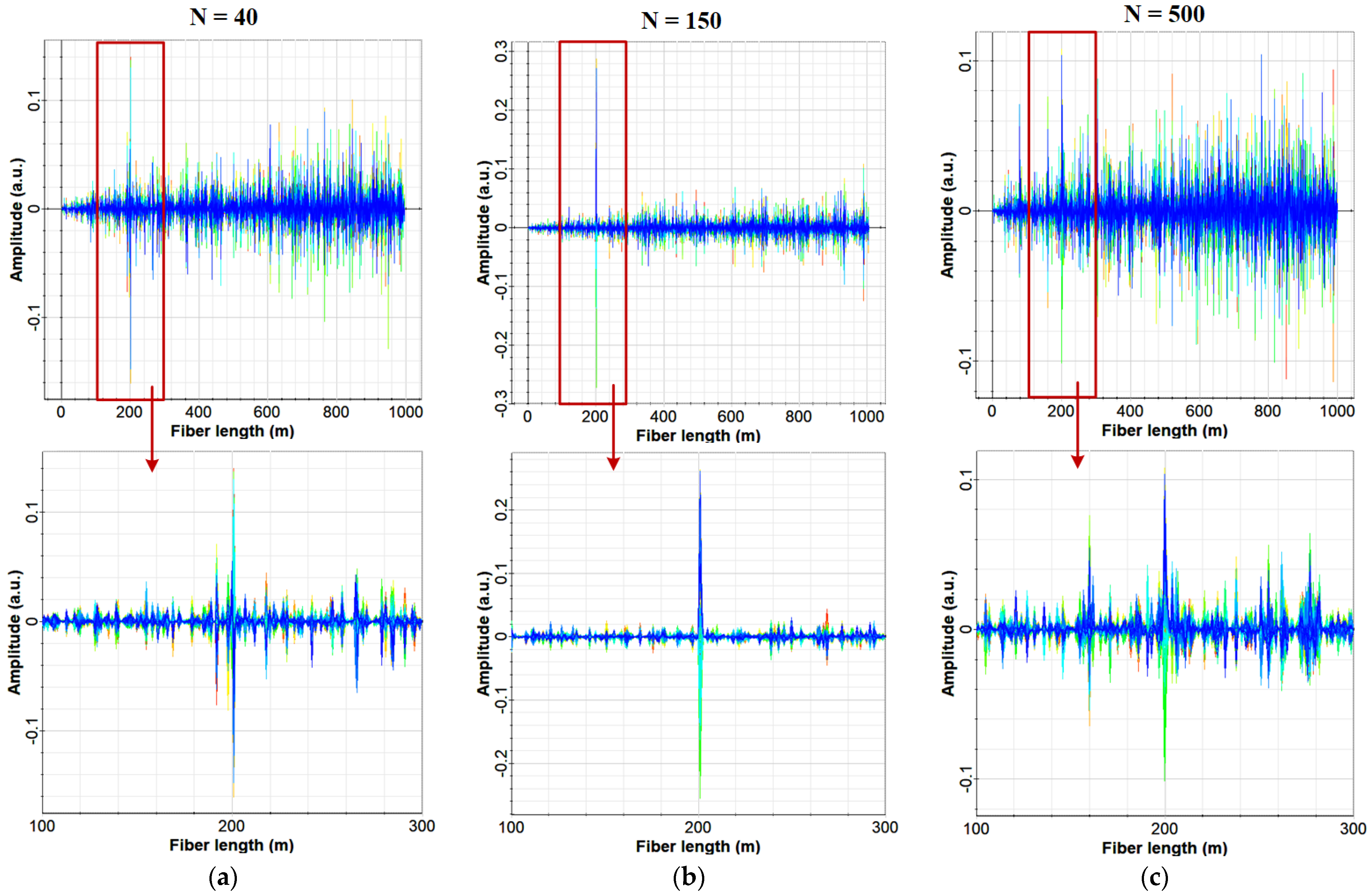The Sensing Attack: Mechanism and Deployment in Submarine Cable Systems
Abstract
1. Introduction
2. Principle and Key Parameters of the Sensing Attack
2.1. Attack Modes: From Jamming to Sensing
2.2. Principle of the Sensing Attack
2.3. Key Parameters of the Sensing Attack
- 1.
- Sensing Range (L)
- 2.
- Spatial Resolution
- 3.
- Frequency Measurement Range
3. Deployment Strategy of the Sensing Attack in Submarine Cable Systems
4. Simulation of the Sensing Attack Based on OptiSystem
4.1. Discrete Scattering Model
4.2. Optimal Spatial Sampling Interval
4.3. Multi-Point Sensing Performance
5. Conclusions
Author Contributions
Funding
Data Availability Statement
Conflicts of Interest
Abbreviations
| DAS | Distributed Acoustic Sensing |
| NJA | Narrowband Jamming Attack |
| ITU | International Telecommunication Union |
| ICPC | International Cable Protection Committee |
| DOFS | Distributed Optical Fiber Sensing |
| (D)WDM | (Dense) Wavelength Division Multiplexing (DWDM) |
| C-OTDR | Coherent Optical Time-Domain Reflectometry |
| φ-OTDR | Phase-sensitive Optical Time-Domain Reflectometry |
| SNR | Signal-to-Noise Ratio |
References
- European Commission; Joint Research Centre. Risks and Protection of Subsea Cable Networks; JRC142001; Publications Office of the European Union: Luxembourg, 2024. [Google Scholar]
- Launch of International Advisory Body to Support Resilience of Submarine Telecom Cables. Available online: https://www.itu.int/en/mediacentre/Pages/PR-2024-11-29-advisory-body-submarine-cable-resilience.aspx (accessed on 29 November 2024).
- Natalino, C.; Schiano, M.; Giglio, A.D.; Wosinska, L.; Furdek, M. Experimental Study of Machine-Learning-Based Detection and Identification of Physical-Layer Attacks in Optical Networks. J. Lightw. Technol. 2019, 37, 4173–4182. [Google Scholar] [CrossRef]
- Yan, Y.; Zheng, H.; Zhao, Z.; Guo, C.; Wu, X.; Hu, J.; Lau, A.P.T.; Lu, C. Distributed Optical Fiber Sensing Assisted by Optical Communication Techniques. J. Lightw. Technol. 2021, 39, 3654–3670. [Google Scholar] [CrossRef]
- Zhang, X.; Zhang, Y.; Wang, L.; Yu, K.; Liu, B.; Yin, G.; Liu, K.; Li, X.; Li, S.; Ding, C.; et al. Current Status and Future of Distributed Fiber Optic Sensing Technology Research and Application. Acta Opt. Sin. 2024, 44, 0106001. [Google Scholar]
- Guerrier, S.; Benyahya, K.; Dorize, C.; Awwad, E.; Mardoyan, H.; Renaudier, J. Vibration Detection and Localization in Buried Fiber Cable after 80km of SSMF Using Digital Coherent Sensing System with Co-Propagating 600Gb/s WDM Channels. In Proceedings of the Optical Fiber Communications Conference and Exhibition (OFC), San Diego, CA, USA, 6–10 March 2022. [Google Scholar]
- Lin, J.; Wang, Q.; Zhang, W.; Shu, J.; Zhang, L.; Tang, Q. Estimation of Submarine Cable Location Using Optical-Fiber Distributed Acoustic Sensing Combined with Ship-Borne Sound Sources. J. Lightw. Technol. 2025, 43, 8917–8926. [Google Scholar] [CrossRef]
- Flores, D.M.; Mercerat, E.D.; Ampuero, J.P.; Rivet, D.; Sladen, A. Identification of Two Vibration Regimes of Underwater Fibre Optic Cables by Distributed Acoustic sensing. Geophys. J. Int. 2023, 234, 1389–1400. [Google Scholar] [CrossRef]
- Fukushima, S.; Shinohara, M.; Nishida, K.; Takeo, A.; Yamada, T.; Yomogida, K. Detailed S-wave Velocity Structure of Sediment and Crust off Sanriku, Japan by a New Analysis Method for Distributed Acoustic Sensing Data Using a Seafloor Cable and Seismic Interferometry. Earth Planets Space 2022, 74, 92. [Google Scholar] [CrossRef]
- Nakano, M.; Ichihara, M.; Suetsugu, D.; Ohminato, T.; Ono, S.; Vaiomounga, R.; Kula, T.; Shinohara, M. Monitoring Volcanic Activity with Distributed Acoustic Sensing Using the Tongan Seafloor Telecommunications Cable. Earth Planets Space 2024, 76, 25. [Google Scholar] [CrossRef]
- Landrø, M.; Bouffaut, L.; Kriesell, H.J.; Potter, J.R.; Rørstadbotnen, R.A.; Taweesintananon, K.; Johansen, S.E.; Brenne, J.K.; Haukanes, A.; Schjelderup, O.; et al. Sensing Whales, Storms, Ships and Earthquakes Using an Arctic Fibre Optic Cable. NPG Sci. Rep. 2022, 12, 19226. [Google Scholar] [CrossRef] [PubMed]
- Siuzdak, J.; Kowalczyk, M.; Marzęcki, M. Jamming of Optical Network Operation in Physical Layer. Int. J. Electron. Telecommun. 2024, 70, 969–977. [Google Scholar] [CrossRef]
- Bensalem, M.; Singh, S.K.; Jukan, A. On detecting and Preventing Jamming Attacks with Machine Learning in Optical Networks. In Proceedings of the IEEE Global Communications Conference (GLOBECOM), Waikoloa, HI, USA, 9–13 December 2019. [Google Scholar]
- Chen, M.; Masoudi, A.; Brambilla, G. Performance Analysis of Distributed Optical Fiber Acoustic Sensors Based on φ-OTDR. Opt. Express 2019, 27, 9684–9695. [Google Scholar] [CrossRef] [PubMed]
- He, Z.; Liu, Q. Optical Fiber Distributed Acoustic Sensors: A Review. J. Lightw. Technol. 2021, 39, 3671–3686. [Google Scholar] [CrossRef]
- Chen, X.; Zou, N.; Liang, L.; He, R.; Liu, J.; Zheng, Y.; Wang, F.; Zhang, X.; Zhang, Y. Submarine Cable Monitoring System Based on Enhanced COTDR with Simultaneous Loss Measurement and Vibration Monitoring Ability. Opt. Express 2021, 29, 13115–13128. [Google Scholar] [CrossRef] [PubMed]
- Zhang, X.P.; Chen, X.H.; Liang, L.; Zhao, S.; He, R.; Tong, S.; Wang, F.; Zou, N.; Zhang, Y. Enhanced C-OTDR-Based Online Monitoring Scheme for Long-Distance Submarine Cables. Acta Opt. Sin. 2021, 41, 1306001. [Google Scholar]
- ITU-T Recommendation G.973.2; Multichannel DWDM Applications with Single Channel Optical Interfaces for Repeaterless Optical Fibre Submarine Cable Systems. ITU: Geneva, Switzerland, 2011.
- Tosi, D.; Molardi, C.; Sypabekova, M.; Blanc, W. Enhanced Backscattering Optical Fiber Distributed Sensors: Tutorial and Review. IEEE Sens. J. 2021, 21, 12667–12678. [Google Scholar] [CrossRef]




| Parameters | Value | Units |
|---|---|---|
| Reference wavelength | 1550 | nm |
| Laser linewidth | 3 | kHz |
| Fiber attenuation | 0.2 | dB/km |
| Fiber core refractive index | 1.5 | / |
| Fiber effective area | 80 | µm2 |
| Rayleigh backscattering | 50 × 10−6 | 1/km |
| Pulse duration | 10 | ns |
| Pulse repetition rate | 10 | kHz |
Disclaimer/Publisher’s Note: The statements, opinions and data contained in all publications are solely those of the individual author(s) and contributor(s) and not of MDPI and/or the editor(s). MDPI and/or the editor(s) disclaim responsibility for any injury to people or property resulting from any ideas, methods, instructions or products referred to in the content. |
© 2025 by the authors. Licensee MDPI, Basel, Switzerland. This article is an open access article distributed under the terms and conditions of the Creative Commons Attribution (CC BY) license (https://creativecommons.org/licenses/by/4.0/).
Share and Cite
Song, H.; Chen, X.; Gao, J.; Yang, T.; Xi, J.; Zhu, X.; Sun, S.; Yu, W.; Bai, X.; Wu, C.; et al. The Sensing Attack: Mechanism and Deployment in Submarine Cable Systems. Photonics 2025, 12, 976. https://doi.org/10.3390/photonics12100976
Song H, Chen X, Gao J, Yang T, Xi J, Zhu X, Sun S, Yu W, Bai X, Wu C, et al. The Sensing Attack: Mechanism and Deployment in Submarine Cable Systems. Photonics. 2025; 12(10):976. https://doi.org/10.3390/photonics12100976
Chicago/Turabian StyleSong, Haokun, Xiaoming Chen, Junshi Gao, Tianpu Yang, Jianhua Xi, Xiaoqing Zhu, Shuo Sun, Wenjing Yu, Xinyu Bai, Chao Wu, and et al. 2025. "The Sensing Attack: Mechanism and Deployment in Submarine Cable Systems" Photonics 12, no. 10: 976. https://doi.org/10.3390/photonics12100976
APA StyleSong, H., Chen, X., Gao, J., Yang, T., Xi, J., Zhu, X., Sun, S., Yu, W., Bai, X., Wu, C., & Wei, C. (2025). The Sensing Attack: Mechanism and Deployment in Submarine Cable Systems. Photonics, 12(10), 976. https://doi.org/10.3390/photonics12100976




